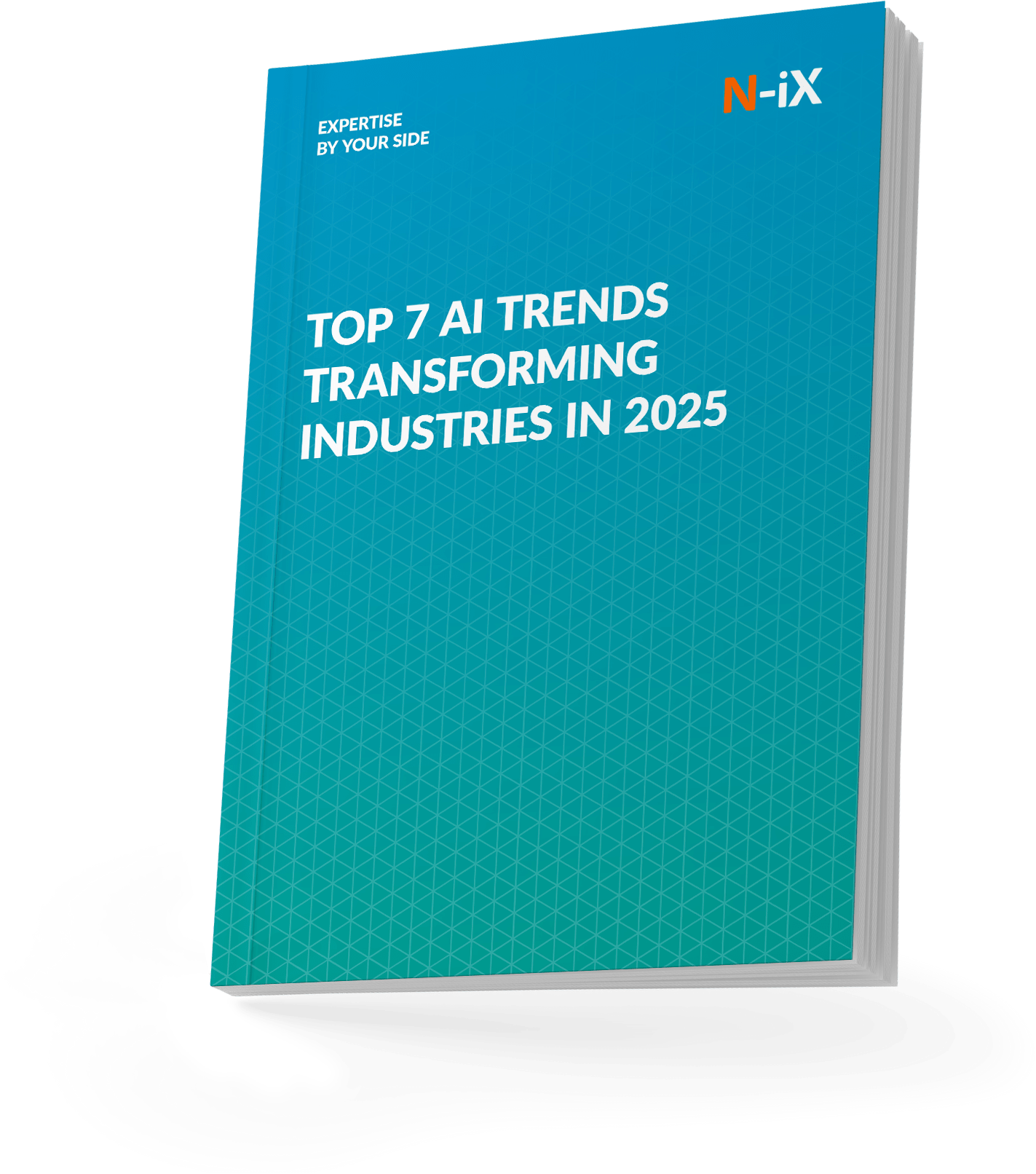The use of AI in telecommunications is at its all-time high right now, with the future seeming even brighter. According to Precedence Research, by the end of 2033, the global AI in the telecommunication market is expected to reach an impressive $42.66B.

What is causing such a surge of interest in AI consulting services among telecoms? Global traffic and the amount of network equipment are growing dramatically. According to the Sandvine Global Internet Phenomena Report, a global traffic volume exceeds 33 exabytes per day. The rapid increase in data flow and the complexity of modern telecom infrastructures make network management complicated, expensive, and time-consuming. AI can optimize and automate networks, keep them healthy and secure while at the same time reducing operational costs. Let's take a closer look at the future of AI in telecom industry and how you can implement it while overcoming the most common challenges.
5 most common AI use cases in telecom
Many industries value AI for its exceptional ability to analyze vast amounts of data quickly and accurately, uncovering patterns, trends, and insights that would be difficult or impossible for humans to detect. As an industry with constant access to vast amounts of data, it is unsurprising that telecom and AI go together better than peanut butter and jelly. Let's take a closer look at the most common ways this technology is used in telecommunications.
1. Predictive maintenance
Maintaining a network becomes increasingly difficult as it grows and becomes more sophisticated. Fixing issues can be a costly and time-consuming process. Moreover, it can lead to downtimes and service interruptions—something customers do not appreciate.
AI in telecom industry can make a big difference with predictive maintenance. By finding patterns in the historical data, AI and ML algorithms can accurately anticipate and warn about possible hardware failures. This allows telcos to be very proactive at maintaining their equipment and fixing issues before they occur and affect end users.
Furthermore, these algorithms can identify the reason behind each failure, making it possible to fight the problem at its core. This is what happened with one of the world's largest providers of in-flight connectivity and entertainment, Gogo. They partnered up with N-iX, which improved the quality of their in-flight Internet and made it possible to predict equipment failures. Moreover, Data Science models built by the N-iX team helped identify the leading causes of ill-performing antennas. As a result, Gogo solved the client's issue, which led to wasting costs and downtime.
2. Network optimization
As companies realize the value of using AI in telecommunication network infrastructure, more and more are willing to invest in it. According to IDC, 63.5% of telecom companies are actively implementing AI to improve their network infrastructure.
For instance, a common use of AI in telecommunications is building self-optimizing networks (SONs). Such networks are automatically monitored by AI algorithms that detect and accurately predict network anomalies. Furthermore, they can proactively optimize and reconfigure the network to ensure that end-users enjoy stable performance. The cost of managing major outages is a significant challenge for telecom providers, as seen with Rogers in 2022 when over 12M cable and cellular customers were affected. AI can help telecommunication businesses boost productivity by analyzing router risks and preparing workforces for potential outages.
3. Virtual assistants and chatbots
Virtual assistants and chatbots are another example of common applications of AI in telecom. Conversational AI platforms are one of the biggest influencers on the growth of AI in the telecommunications market, as they can automate customer request handling.
Long waiting periods are the bane of existence for good customer service and are something that human-operated call centers are very prone to. By scaling conversations to simple queries, chatbots can respond to massive amounts of customer inquiries with impressive speed. This, plus the ability to provide uninterrupted service 24/7, reflects very positively on customer satisfaction. Indeed, according to Forbes, a LatAm telecommunications company boosted call center agent productivity by 25% and improved customer experience by utilizing AI-driven recommendations.

As virtual assistants develop and learn to handle more complicated requests, the need for human operators decreases. This can help companies significantly reduce their expenses. In fact, as IBM reports, the use of chatbots can lead to over 30% in customer support cost savings.
4. Fraud detection and prevention
The fraud detection and prevention market reached $28.8B in 2024 and is expected to grow to $63.2B by 2029 with a CAGR of 17%. Despite this, malicious attacks on businesses still cause organizations over $4.35M of losses.
With AI's excellent analytical capabilities, it is not surprising that many industries, including telecom, are finding it useful in battling fraud. The most prominent advantage of AI-powered fraud analytics is its ability to prevent fraud altogether. The system blocks the corresponding user or service as soon as it detects suspicious activity, not allowing fraud to occur. All of this is done automatically, making the chances of not responding to an attack in time very slim.
5. Robotic process automation (RPA)
RPA is a form of digital transformation that relies on implementing AI. Telcos can use RPA to automate data entry, order processing, billing, and other back-office processes that require lots of time and manual work. This frees up your employees' time, lets them focus on critical tasks, and reduces the number of errors that manual labor is prone to. As a result, your office runs smoother, your employees are more productive, and your customers enjoy error-free service.

With so much to gain, it is not that surprising that more than 80% of telecom organizations have already begun their journey in RPA, according to Matellio.
Explore the AI landscape of 2025—get the guide with top trends!


Success!

Top challenges of using AI in telecom and how to solve them
Even though the global AI in telecom sector is growing rapidly, implementing it can still be tricky for many businesses. Besides being unable to recognize the need for AI or identify appropriate business use cases, the most common challenges of implementing AI in telecom are as follows:
1. Unstructured or incomplete data
Implementing an AI system without access to relevant data is a fruitless endeavor. Many organizations struggle with data collection because of several common issues:
- Fragmented data. Data is collected and stored by different systems without a single unified database from where it can be accessed.
- Unstructured data. A big mass of uncategorized data without any context or explanation of what it is related to is not very useful to any AI algorithm.
- Incomplete data. Using data with missing components can lead to inconsistent or faulty learning by the AI system.
N-iX tip: Since AI algorithms require clean, well-structured data, a substantial part of any ML project is dedicated to ETL (extracting, transforming, loading) and data cleanup. Therefore, it is important to put an appropriate Big Data engineering ecosystem (based on Apache Hadoop or Spark) in place to collect, integrate, store, and process data from numerous siloed data sources.
2. Need for additional AI expertise
Although, in recent years, AI has become widely adopted, many organizations still struggle to source talent with advanced AI skills. With limited local talent, building an in-house team can take time and yield little results.
A better option is to look for a technical partner that would implement AI in telecommunications for you. However, finding a vendor with enough competence and experience to successfully build an AI system can be a challenge. Moreover, implementing AI can be quite pricey, so it is crucial to start your project with the right partner.
N-iX tip: Do your research before opting for a partnership with a software company. Take a look at their practical experience with AI, and find out what clients are saying about them. Trusted review platforms such as Clutch can give you a good understanding of whether a vendor can deliver the expected results. Look for a technology partner with expertise in ML/AI, Big Data, cloud, DevOps, and cybersecurity to help you meet your specific business needs.
3. Technical integration
Old legacy systems are one of the most common reasons why many AI integration projects fail. Before committing to such a project, make sure your IT infrastructure is ready to handle it.
N-iX tip: There are several things you can do to prepare your system for the upcoming AI project:
- Set up a unified database where all the data required by the system will be stored;
- Use data lakes, as well as edge or cloud computing, to eliminate any issues that can occur when storing large amounts of data;
- Do not hesitate to give your data collection and storage process a complete overhaul if you notice that collected data is disparate or unstructured;
- Ensure you have the required hardware and software to handle the new system.
Find a reliable technology partner to audit your legacy system and help you with the Discovery Phase to validate your ideas, choose the most suitable architecture and tech stack, and prepare all the deliverables needed for the successful project kick-off.

Wrap-up
The rapid growth of AI in telecommunications reflects its growing importance in the industry. As more companies increase their investments in cognitive technologies, it is essential to keep up.
However, when dealing with complex or unfamiliar technologies, it is equally important to pick the right tech partner who will support you along the way and help you leverage all the benefits of AI in telecom. If you are looking for a partner with over a decade of experience with AI and software development in telecommunications―look no further!
How N-iX can help you take advantage of AI in telecommunications
- N-iX has extensive experience in forming partnerships with leading telecommunications companies, such as Gogo and Lebara, and helping them take full advantage of AI capabilities;
- With over 2,200 tech professionals in 25 locations across Europe and the Americas, N-iX delivers expert solutions in Artificial Intelligence & Machine Learning, Generative AI, Computer Vision, Big Data, Data Science, and other tech domains;
- Our data team spans over 200 experts skilled in the implementation of virtual assistants and chatbots, predictive maintenance, network optimization, and fraud detection systems;
- N-iX complies with international data protection regulations and standards, including ISO 27001:2013, PCI DSS, ISO 9001:2015, abd GDPR to safeguard our clients' sensitive data;
- ISG has recognized N-iX as a Rising Star in engineering services for the UK market.
Have a question?
Speak to an expert




